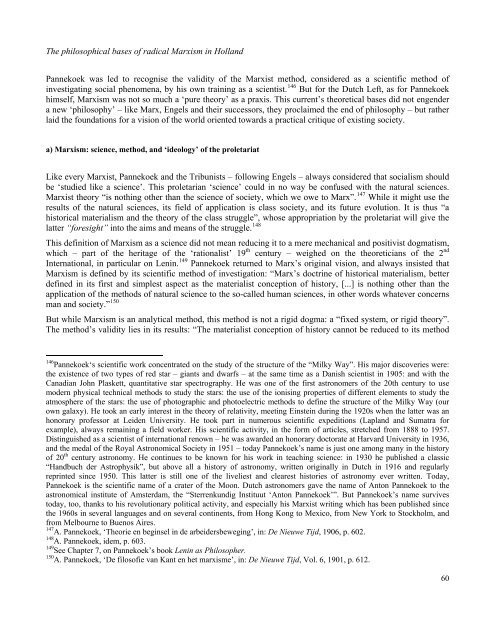The German-Dutch Communist Left - Libcom
The German-Dutch Communist Left - Libcom
The German-Dutch Communist Left - Libcom
Create successful ePaper yourself
Turn your PDF publications into a flip-book with our unique Google optimized e-Paper software.
<strong>The</strong> philosophical bases of radical Marxism in Holland<br />
Pannekoek was led to recognise the validity of the Marxist method, considered as a scientific method of<br />
investigating social phenomena, by his own training as a scientist. 146 But for the <strong>Dutch</strong> <strong>Left</strong>, as for Pannekoek<br />
himself, Marxism was not so much a ‘pure theory’ as a praxis. This current’s theoretical bases did not engender<br />
a new ‘philosophy’ – like Marx, Engels and their successors, they proclaimed the end of philosophy – but rather<br />
laid the foundations for a vision of the world oriented towards a practical critique of existing society.<br />
a) Marxism: science, method, and ‘ideology’ of the proletariat<br />
Like every Marxist, Pannekoek and the Tribunists – following Engels – always considered that socialism should<br />
be ‘studied like a science’. This proletarian ‘science’ could in no way be confused with the natural sciences.<br />
Marxist theory “is nothing other than the science of society, which we owe to Marx”. 147 While it might use the<br />
results of the natural sciences, its field of application is class society, and its future evolution. It is thus “a<br />
historical materialism and the theory of the class struggle”, whose appropriation by the proletariat will give the<br />
latter “foresight” into the aims and means of the struggle. 148<br />
This definition of Marxism as a science did not mean reducing it to a mere mechanical and positivist dogmatism,<br />
which – part of the heritage of the ‘rationalist’ 19 th century – weighed on the theoreticians of the 2 nd<br />
International, in particular on Lenin. 149 Pannekoek returned to Marx’s original vision, and always insisted that<br />
Marxism is defined by its scientific method of investigation: “Marx’s doctrine of historical materialism, better<br />
defined in its first and simplest aspect as the materialist conception of history, [...] is nothing other than the<br />
application of the methods of natural science to the so-called human sciences, in other words whatever concerns<br />
man and society.” 150<br />
But while Marxism is an analytical method, this method is not a rigid dogma: a “fixed system, or rigid theory”.<br />
<strong>The</strong> method’s validity lies in its results: “<strong>The</strong> materialist conception of history cannot be reduced to its method<br />
146 Pannekoek‘s scientific work concentrated on the study of the structure of the “Milky Way”. His major discoveries were:<br />
the existence of two types of red star – giants and dwarfs – at the same time as a Danish scientist in 1905: and with the<br />
Canadian John Plaskett, quantitative star spectrography. He was one of the first astronomers of the 20th century to use<br />
modern physical technical methods to study the stars: the use of the ionising properties of different elements to study the<br />
atmosphere of the stars: the use of photographic and photoelectric methods to define the structure of the Milky Way (our<br />
own galaxy). He took an early interest in the theory of relativity, meeting Einstein during the 1920s when the latter was an<br />
honorary professor at Leiden University. He took part in numerous scientific expeditions (Lapland and Sumatra for<br />
example), always remaining a field worker. His scientific activity, in the form of articles, stretched from 1888 to 1957.<br />
Distinguished as a scientist of international renown – he was awarded an honorary doctorate at Harvard University in 1936,<br />
and the medal of the Royal Astronomical Society in 1951 – today Pannekoek’s name is just one among many in the history<br />
of 20 th century astronomy. He continues to be known for his work in teaching science: in 1930 he published a classic<br />
“Handbuch der Astrophysik”, but above all a history of astronomy, written originally in <strong>Dutch</strong> in 1916 and regularly<br />
reprinted since 1950. This latter is still one of the liveliest and clearest histories of astronomy ever written. Today,<br />
Pannekoek is the scientific name of a crater of the Moon. <strong>Dutch</strong> astronomers gave the name of Anton Pannekoek to the<br />
astronomical institute of Amsterdam, the “Sterrenkundig Instituut ‘Anton Pannekoek’”. But Pannekoek’s name survives<br />
today, too, thanks to his revolutionary political activity, and especially his Marxist writing which has been published since<br />
the 1960s in several languages and on several continents, from Hong Kong to Mexico, from New York to Stockholm, and<br />
from Melbourne to Buenos Aires.<br />
147 A. Pannekoek, ‘<strong>The</strong>orie en beginsel in de arbeidersbeweging’, in: De Nieuwe Tijd, 1906, p. 602.<br />
148 A. Pannekoek, idem, p. 603.<br />
149 See Chapter 7, on Pannekoek’s book Lenin as Philosopher.<br />
150 A. Pannekoek, ‘De filosofie van Kant en het marxisme’, in: De Nieuwe Tijd, Vol. 6, 1901, p. 612.<br />
60
















